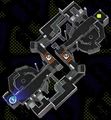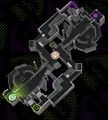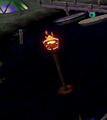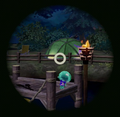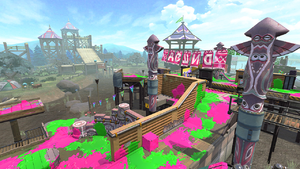Camp Triggerfish
Camp Triggerfish is a multiplayer stage in Splatoon and Splatoon 2. It appears to be a wooden fort built over a lake, surrounded by a thick forest.
Layout
Splatoon
Camp Triggerfish consists of a series of bridges over water, and a large area near the team's spawn, along with a shelter that can only be accessed via a grated pathway in Turf War. Both bases at Camp Triggerfish has a set of floodgates that open and close periodically. When the gates are down, it is easier for other teams to enter. In Turf War, the floodgates lower when there's one minute left on the clock, allowing for access to the shelter. In Ranked Battles, they stay down for the entire match. Teams begin on opposite sides of the stage, with bases immediately splitting into two paths. The left path leads into a large, circular area surrounded partially by a net over water. This area extends into a narrow walkway ending in high, wooden walls. The path right of each team's base leads directly into the central walkways, which are also accessible by climbing over the aforementioned walls. This path leads into an open area below a series of net catwalks, which can be used to enter the other team's base or the shelters behind their floodgates. Camp Triggerfish features ambiance of chirping birds, and when players are close to the lake, rippling water as well. Upon spawning, the chirping of crickets can be briefly heard before fading. The area in front of spawn is a very large area to grab turf. However, since they are very close to the areas where the enemy team can cross over to your side, they tend to attract enemy players that manage to sneak over to your side. Finally, these areas also lead to the backside of the walls of the Center Flatboards, which allow you to reach the top of the wall as a good perch for chargers. The center "flatboards" are areas in the middle of the map that don't have much turf to cover, nor any direct path to cross the water canal, but many of the early splats will occur here due to the short distance between sides. On both sides, there are three sections each where grates go over the water. While only one of these (the farthest) allow the player to cross over to the other side of the map, it should be noted that these grated areas are great spots to shoot enemies that are on the other side. Though, you are very exposed while doing this, as you will fall through the grates into the water if you turn into a squid. Floodgate Shelters are areas on the far ends of the map that lead directly to the open area in front of spawn. While this area is a good spot to sneak over to the other side to get enemy turf and surprise splats, it is easily accessible by the other team via the floodgates that drop in the final minute of the battle.
Splatoon 2
The most notable change made is the change to the floodgates and area immediately behind them. Instead of having two floodgates, they've been replaced by a single wider gate and the area behind has been changed from a narrow corridor to an open square plaza. Two Inkrails have been added to each side of the map, one directly in front of the Spawn Point allowing players to infiltrate the enemy side. The other is behind the wall close to the center of the map which allows a quicker path to the left side of the map.
Ranked Battle Terrain
Splat Zones
Camp Triggerfish has two splat zones located on opposite sides of the canal in the middle of the map. It is possible for one team to completely gain control of both splat zones without ever setting foot into enemy territory just by shooting across the canal. The blocks on top of the Splat Zones don't count towards taking control of one.
Tower Control
Splatoon
The tower starts in the center of the two center platforms on an added platform in between. When activated, the tower then travels over the water dividing the two sides, passing by the many grated areas on either side, until it climbs up the gated section, before ending in the middle of the wide pathway in front of the spawn point.
Splatoon 2
During Tower Control, an additional wooden path with connect the area immediately in front of spawn to the platform the the right making accessing the enemy side easier.
Checkpoints have been added:
- The first checkpoint will be located at the turn from the central area.
- The second checkpoint will be located underneath the netted walkway on the newly added wooden path.
Rainmaker
The Rainmaker in this map starts on top of an added platform in the center of the map, bridging the gap between the two sides. The goals are located on opposite corners of the map, inside the Floodgate Shelter on the side closest to the opposing team's respawn point. A stack of blocks and an inkable wall have been added to help players reach vantage points and other parts of the map quicker, as well as wooden platform added next to each of the teams' bases so they can access their side of the goal faster. Two blocks have also been added to the roped bridges to aide in attacking any player on top of the grated platform on the other side, and to provide a hiding spot for both teams.
Clam Blitz
The goal is in front of the spawn point, with the gates lowering instantly. A piece of terrain is present, allowing for teams to get from their spawn point to the area that has the gate leading to the larger area. However, the Inkrail near the spawn point is still there.
Splatoon
File:S Stage Camp Triggerfish.png
| Added in | July 24, 2015 |
| Total area | 2,316pp |
| Features | Moving gates |
Camp Triggerfish underwent a series of multiple changes between its development period and release.
Pre-release version

The pre-release version included many differences, such as:
- The circular areas left of teams' bases included a much taller, independent cylinders to climb.
- The short stacks of boxes on the central walkways were not present.
- Many walls found through out the final version of the map are not present at all.
- The walkway near the round area near both teams' spawns is not present because of this.
- The walkways near the center were much closer to the water, lower than the area at the end of each side.
- The roped bridge that leads from one side to the other was not present.
- The grated platform closest to each teams' spawn extended farther out on to the water.
- The wooden bridge next to both spawns was roped, allowing players to fall through it onto solid ground below.
Release version
Camp Triggerfish was released on July 24, 2015.
Version history
| Version | Adjustments |
|---|---|
| 2.1.0 |
|
| 2.8.0 |
|
Maps
-
Turf War
-
Splat Zones
-
Tower Control
-
Rainmaker
Gallery
-
A picture of the Spawn Base.
-
An Inkling with a Range Blaster shooting at the other side.
-
A green Inkling charging into battle.
-
An Inkling using a .52 Gal within Camp Triggerfish
-
A Charger-user firing an explosion of ink.
-
A team of Inklings posing together in an older version of Camp Triggerfish.
-
This picture showcasing the Inkling's clothing also shows some of the background of Camp Triggerfish.
-
A shot of an older Camp Triggerfish, showing metal barrels in the sea.
-
An Inkling splatting an enemy with the Splat Charger at an early version of Camp Triggerfish.
-
Camp Triggerfish during Splatfest.
-
A lit torch at Camp Triggerfish.
-
A jellyfish waving at Camp Triggerfish from Camp Jellyfish.
-
The night sky over Camp Triggerfish during a Splatfest.
-
Several Inklings in squid form jumping at the edge of Camp Triggerfish, with Camp Jellyfish in the background.
-
Concept art of various objects at Camp Triggerfish.
-
Concept art of different locations. "Playground" is an early sketch of Camp Triggerfish.
-
A bird's-eye view of Camp Triggerfish.
Splatoon 2
| Added in | April 24 2018 |
| Total area | 2,338pp |
| Features | Moving gates & Inkrails & SpongesTW & SZ & TC |
The return of Camp Triggerfish to Splatoon 2 was announced in the Nintendo Direct at March 8, 2018 along with the stage Piranha Pit. It was released on April 25, 2018 at Template:UTC along with Version 3.0.[1]
Gallery
-
Promo image
-
Promo image
-
Promo image
-
Promo image showing Camp Jellyfish
Quotes
| View the quotation page. |
Trivia
- The name is based on the real-life triggerfish.
- The Spanish name of this location is misspelled; its name is "Campamento Arowana" when it should be called "Campamento Arawana" since "Arowana" doesn't exist in that language.
- The Spanish and Italian versions of Splatoon were also the only editions that didn't include Arowana in Arowana Mall. The Spanish version already included this fish name in this setting, while the Italian version has no setting called Arowana.
- Camp Jellyfish can be seen across the lake that Camp Triggerfish is built on.
- According to the first artbook, it takes 30 minutes to reach Camp Triggerfish from the city by express train. The totem poles are replicas of the ones that were made to honor the ancestors of the Inklings.
Splatoon
- Camp Triggerfish has been shown in a multitude of trailers and screenshots for Splatoon, only releasing to the map pool on July 24th; this makes it the longest-known-about stage to be released.
- The Squid Sisters quotes, "Apparently they've rebuilt this place tons of times" and "Why not pick a design and THEN start building it?", are likely a reference to the long development period of Camp Triggerfish.
- The Squid Sisters quotes, “Ahh, a campsite! Did you bring the marshmallows?” | “No, but I brought hot dogs!” and "Let's roast marshmallows over the campfire!" | "Splat that! Team Hot Dog for LIFE!", are a reference to the third North American Splatfest, for which the theme was "Would you rather roast a marshmallow or a hot dog?"
- Parachuters can sometimes be seen above Camp Triggerfish. It is unknown who or what they are, but they are probably patrons of Camp Jellyfish.
- Before Version 2.1.0, a glitch existed that allowed players to jump across the gap between the the two sides in the middle of the camp. Although the timing was strict, it was a nasty trick that could be achieved consistently, but has been patched out of the game.
Splatoon 2
- According to an Off the Hook intro for this stage, Pearl was the designer of Camp Triggerfish and that the stage is owned by Pearl's family: “Hey, did you know I designed this stage back in the day?” | “Yup. Your parents own the place, right?”.
- It is also stated that Pearl wrote the camp song as well that Marie mentions in the first game.

